Learn How to Set Your Flight to Music
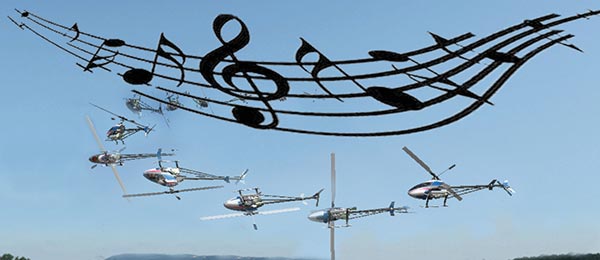
Written by Mark Fadely RC Helicopters Column As seen in the January 2013 issue of Model Aviation.
W elcome back. Many helicopter pilots put an incredible number of hours into improving their flying. Are you one of those people? If you are, then you will like the subject of this month’s column. It is about becoming better and integrating music into your flying routine.
So, You Think You’re a Pretty Good Pilot?
Do all of your buddies applaud after your flights at the local field? Can you feel your confidence growing when you are in your element (the club field)? Are you thinking about competing? If these things describe you, then you will want to read on. If you have become proficient in your flying, it will be natural to augment your flights with accompanying music. As in many other types of performances, it is more fun to watch a heli fly when it “dances” to music. Heck, most fireworks shows today are set to music. At major helicopter events, the flying performances are tuned to the music with expert synchronization of the beat and mood.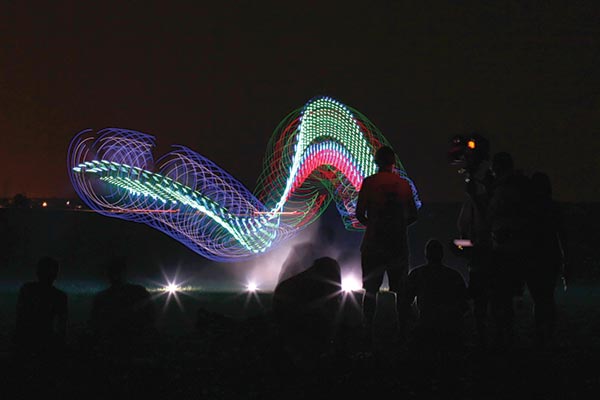
Bobby Watts’ heli is shown here in the midst of winning another night-fly competition. Bobby designed a microprocessor-controlled lighting system called the Digital Aerial Light Controlling Onboard Nodule (DALCON) that automatically stays synchronized to the music.
Face the Music
The old style of flying helis to background music is being replaced by well-thought-out flying routines that incorporate precision planning and custom musical scores. It takes many hours to put together a pleasing flight routine combined with a well-choreographed music track. It is hard work to design the flying to music, but it pays off with a routine that looks better because it follows the music in tempo and mood. You can spend a few minutes picking a good song from the radio to fly to, or you can spend months making sure everything is just right with a custom-made mix.Harder Than It Looks
When you give choreography a try, you may find it difficult. When most pilots go up for a flight, they generally have a good idea which maneuvers will be flown. They might vary the order of the moves, or alter some of them. It also does not make much difference if you fly an extra 25 feet before starting the next trick. This changes when you begin choreographing your flying with music. A dance group needs to make every turn and twist on the beat, and the heli must follow suit. If you attempt to fly your favorite maneuvers with better timing, placement, and precision, they will be more difficult. Entering a maneuver early or exiting one late will throw everything off. Although spectators might not fly helicopters, they will notice if your timing is off when the music is playing. The top-level contests include flights to music because it highlights the pilots’ skills and makes an entertaining event.Work It Out on the Simulator
Simulators are the most powerful tools available to advancing helicopter pilots. The simulator is valuable when working out your flight-to-music routine. I recommend working in short segments. Plan where in the flight you will be and insert the music clip in that section so you can fly to it over and over. Looping the music so that it repeats the same segment will accelerate the tweaking process.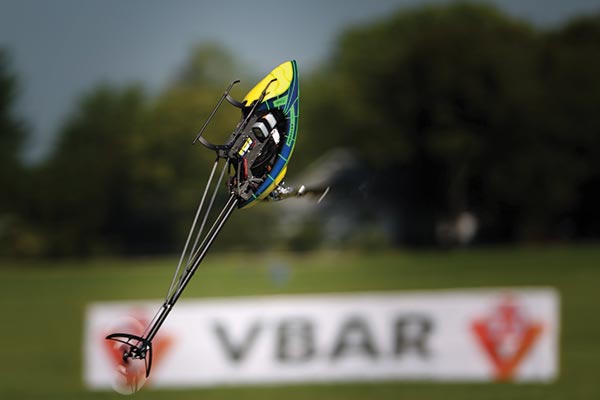
Kyle Dahl is one of the best pilots in the world when it comes to flying a choreographed routine. Here he is Tic-Tocking to the beat during his competition flight.
One element to be aware of is the simulator’s real-world speed. I found that no matter how I adjusted the speed on the simulator, the timing was always slightly different in the real world. After you have flown a couple of choreographed routines, this timing difference will become easy to account for.
What Makes Good Flying Music?
That is a good question. The answer is different for everyone. One thing is for sure—the music needs to have an obvious correlation with the heli’s movements. Think about your favorite maneuver, and then try to imagine a piece of music that would accentuate that move. Major contests require the pilots to perform their routines to precise timing to place well. Choreographed flights serve two purposes. First, flights integrated with music are more entertaining for the spectator, and second, those same flights are easier to judge because segments that do not match the music and rhythm are obvious. It is nearly impossible to find one song that will complement your flying style for an entire flight. A mix of music that lasts approximately four minutes is best. That is enough time to show all your best skills without boring the audience by going on too long. It is important to not repeat anything during the flight. Keep it fresh and new. You are an entertainer, so plan your routine with that in mind. The flight should be captivating for experienced heli pilots as well as spectators who may have never seen a helicopter fly.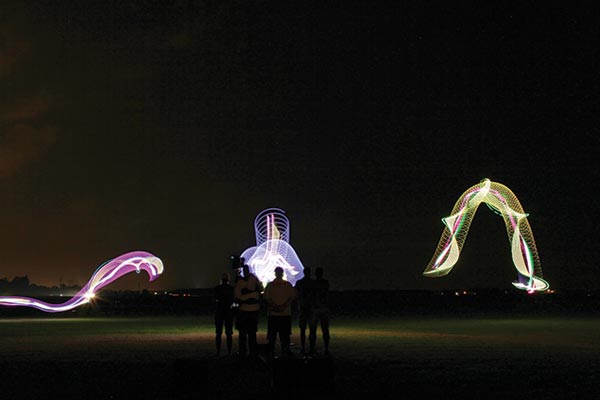
The Mikado helicopter team put on this unreal choreographed triple night flight. Each heli had a different set of neon lights to add to the visual experience.
What is the best way to get started? First you need to find a good way to play music while you fly. Some pilots use their MP3 players and listen through earphones. I never liked this method. The few times I tried it I put an earbud into one ear so that I could still hear the helicopter with the other ear. A small boombox works well, but sometimes it is difficult to hear over the sound of the heli. Jim Stark made a small, portable sound system with a car audio amplifier and two small studio speakers. It was loud enough to hear with the helicopter in the air. Include a number of starts and stops in your flying and in the music. The most obvious timing of the flight to music is when things happen abruptly. Imagine flying along straight and level to stage center, and then you jerk the heli up into a vertical position as the symbols crash in the music.
How Do I Start Mixing My Own Music?
There are many different mixing programs on the market. I have heard of some free online versions that work well. I use a program called Music Studio by Magix, which has worked well for me for a long time. Becoming familiar with the program is half the battle. The mixing software is powerful, and you can perform quite a few elegant tasks with it once you figure out how to use it. Using the program is time consuming. I spent approximately an hour a day for a few months learning techniques with the Music Studio program. Like all software, it seemed slightly overwhelming at first. Now that I have been using it for several years, I can sit down and make a simple mix in minutes. That is a job that used to take me a couple of weeks.Choreography Is a Requirement
All pilots who compete in the Extreme Flight Championships (XFC) or the 3D Masters in Europe must have excellent flight-to-music skills. In fact, the organizers want the competitors to understand the importance of maneuvering their helis in harmony with music. The K-Factor (a percentage of your total score) is high for choreography.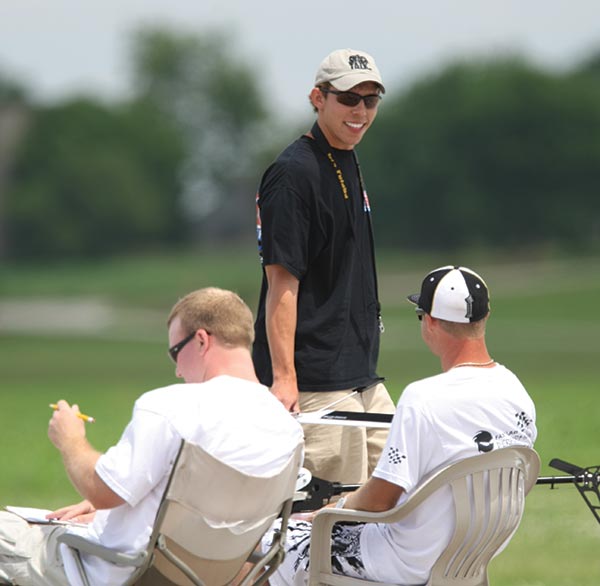
Bobby Watts gets a couple of comments from judge Alan Szabo after his XFC performance. Bobby spends much time choosing music that is perfect for the mood he is trying to portray with each segment of his flights.
This is what is written in the official XFC judging criteria: “The entire flight should be accurately and precisely choreographed to music and/or other suitable sound effects. It should include different types of audible rhythms, beats, tempos, and sounds that reflect the maneuvers, speeds, and attitudes of the aircraft. “Higher marks should be given for choreography with the music to enhance the flight, and the flight choreographed to enhance and present visual impressions where both the music and aircraft are flowing together with each other and acting as a unified entity to display a harmonious presentation. “Marks should be deducted in this category if only portions of the flight don’t follow the music or if portions have no reasonable relationship to the music. Marks should also be deducted if it is obvious that the intent of the maneuver is not in concert with the music or audio.”










Add new comment